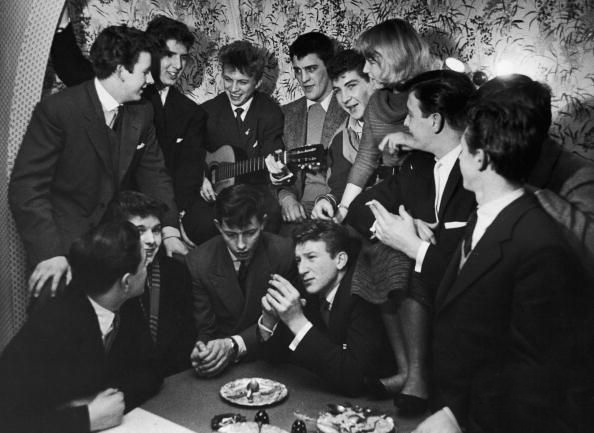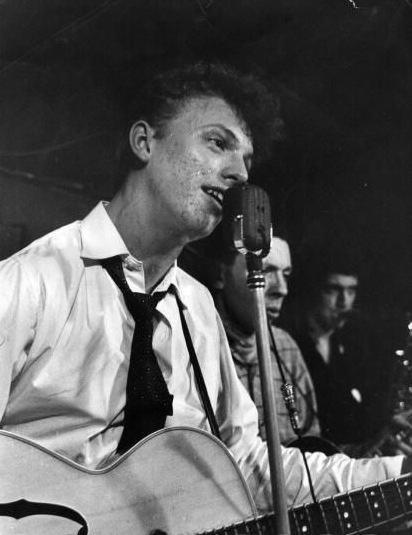| |
| 1954 - 1955 [16-17 yrs] |
| Hicks applied his imitative
skills to copying American country singers. Hicks worked with Jack Fallon
(a Canadian residing in the UK) and "the Sons of the Saddle" at US bases
in the UK. In these contexts, Fallon often introduced him as "Chick Hicks,
all the way from the Grand Old Oprey." |
| |
| 1955 [17 yrs] |
| Between shipboard duty, Hicks
often lived in London and found musical work accompanying American folk
performers (for example playing rhythm guitar for Josh White). He also
found some work playing solo in London's burgeoning coffee bars, clubs,
and/or jazz cellars. These jobs included playing skiffle with Wally Whyton
(who soon after formed the Vipers skiffle group). However, Hicks did not
give up his day job and continued working on board ships, effectively
preventing him from forming any long-term performance commitments, although
working in London did give him ideas and contacts. |
| |
| 1956 [18 years] |
| Hicks officially began
his performance career as a comedian performing with two songwriters:
Lionel Bart (later of Oliver) and Mike Pratt. Their repertoire
was eclectic and included music in the style of the new rock and
roll, country and western, and folk music, and they combined this
original comedy material. One of their first steady engagements
(calling themselves the Cavemen) was at a pub near Waterloo Station
where, as part of their act, they the put together a rock pastiche,
"Rock with the Caveman." Given the skyrocketing success of Elvis
Presley this spring and of Bill Haley and the Comets in previous
months, theirs was as much a parody of rock and roll as it was a
celebration. The whole idea of a "caveman" suggests that they thought
of the genre as decidedly "low brow." |
| Hicks continued to audition
as a comedian, auditioning unsuccessfully for Charing Cross' agents.
He hired photographer and publicity agent John Kennedy as his agent
who in turn, convinced a successful clothier to enter into a management
deal. Larry Parnes was eager to become an English Col. Tom Parker
(Elvis's manager). Eventually he became the major British manager
of British rock. Parnes and Kennedy began by booking Hicks with
the Harold Fielding Agency (for engagements) and with Peter Maurice
Music (for publishing). |
| 26 October. "Rock
with the Caveman" (Steele, Bart, and Pratt) [enters UK charts] recorded
24 September 1956; released in early October; UK #13. |
| November. "Doomsday Rock" / "Elevator Rock" (Decca F 10808). [No chart action.] |
| 4 December. Finsbury
Park Empire, London: Tommy Steele makes his Variety debut. |
| Melody Maker (8 December
1956): "What a phenomenon Rock-'n'-Roll singer and guitarist Tommy
Steele is! A phenomenon because, on Monday, in his London Variety debut
at Finsbury Park Empire, it seemed little short of a miracle that this
19-year-old youth could receive such a rapturous ovation for the little
musical talent he displayed" (8). |
| 14 December. "Singing
the Blues" (Endsley) [enters charts] released in late October 1956
as Decca F 10795; eventually hits UK #1. |
| With Steele's success, Parnes,
Kennedy, Wright, and Tuvey hired Leo Pollini (drums) to form the Steelmen
for live performances. The band would include Pollini, Alan Stuart (sax),
Dennis Price (piano), and Allan Weighell (bass). As Steele became more
successful, Parnes and Kennedy began to transform him into what they would
have described as an "all-round entertainer." In essence, they believed
that success lay in making Steele acceptable to both teenagers and their
parents. As part of this plan, they booked him on the music hall circuit
(or what was left of it). Indeed, like Lonnie Donegan, Steele increasingly
turned to music hall tunes as part of his performance repertoire. |
| Steele served as an example
for other working class males who begin to see pop as a way to improve
their social status. Parnes and Kennedy used Tommy Steele as a template
for the development of other performers, all of who have Dickensian names
of promising sexuality: Marty Wilde, Johnnie Gentle, Tommy Quickly, Billy
Fury, Rory Storm, Johnny Eager. Their marketing did suffer a major setback
when the government conscripted singer, Terry Dene, into the army. Dene
had a nervous breakdown shortly after entering the service and, suddenly,
Parnes and Kennedy's singers seemed less than virile. All of this was
parallel with (and probably in imitation of) American boy singers (Fabian,
Paul Anka, Everly Brothers, etc.). |
| |
| 1957 |
| 15 February. "Knee Deep in the Blues" [Decca F 10849] enters UK charts; UK #15. |
 |
| Tommy Steel at the 2i's, 25 February 1957 |
| 3 May. "Butterfingers"
[Decca F 10877] enters UK charts; UK #25. |
| 16 August. "Water Water"
/ "Handful of Songs" [Decca F 10923] enters UK charts; UK
#5 |
| 30 August. "Shiralee"
[Decca F 10896] enters UK charts; UK #11 |
| 22 November. "Hey You"
[Decca F 10941]; enters UK charts; UK #28 |
 |
| Tommy Steele at the Bread Basket |
| |
| 1958 |
| 7 March. "Nairobi"
[Decca F10991]; enters UK charts; UK #3. |
| 25 April. "Happy Guitar"
[Decca F 10976]; enters UK charts; UK #20. |
| 18 July. "The Only
Man on the Island" [Decca F 11041]; enters UK charts; UK #16. |
| 14 November. "Come On Let's Go" [Decca F 11072]; enters UK charts; UK
#10. |
 |
| Tommy Steele at the Cat's Whisker |
| |
| 1959 |
| 14 August. "Tallahasee
Lassie" [Decca F 1152]; enters UK charts; UK #16. |
| 28 August. "Give Give
Give" [Decca F 1152]; enters UK charts; UK #28. |
| 4 December. "Little White Bull" [Decca F 11177]; enters UK charts; UK
#6. |
| |
| 1960 |
| 23 June. "What a Mouth"
[Decca F 11245]; enters UK charts; UK #5. |
| (See
Dopson 1990) |



